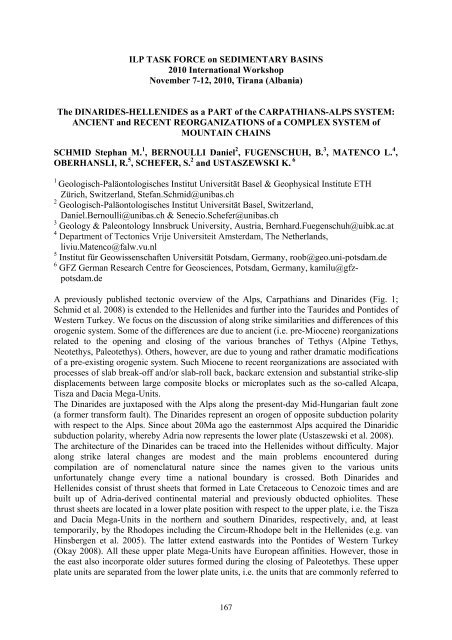DYNAMICS and ACTIVE PROCESSES - International Lithosphere ...
DYNAMICS and ACTIVE PROCESSES - International Lithosphere ...
DYNAMICS and ACTIVE PROCESSES - International Lithosphere ...
Create successful ePaper yourself
Turn your PDF publications into a flip-book with our unique Google optimized e-Paper software.
ILP TASK FORCE on SEDIMENTARY BASINS<br />
2010 <strong>International</strong> Workshop<br />
November 7-12, 2010, Tirana (Albania)<br />
The DINARIDES-HELLENIDES as a PART of the CARPATHIANS-ALPS SYSTEM:<br />
ANCIENT <strong>and</strong> RECENT REORGANIZATIONS of a COMPLEX SYSTEM of<br />
MOUNTAIN CHAINS<br />
SCHMID Stephan M. 1 , BERNOULLI Daniel 2 , FUGENSCHUH, B. 3 , MATENCO L. 4 ,<br />
OBERHANSLI, R. 5 , SCHEFER, S. 2 <strong>and</strong> USTASZEWSKI K. 6<br />
1<br />
Geologisch-Paläontologisches Institut Universität Basel & Geophysical Institute ETH<br />
Zürich, Switzerl<strong>and</strong>, Stefan.Schmid@unibas.ch<br />
2<br />
Geologisch-Paläontologisches Institut Universität Basel, Switzerl<strong>and</strong>,<br />
Daniel.Bernoulli@unibas.ch & Senecio.Schefer@unibas.ch<br />
3<br />
Geology & Paleontology Innsbruck University, Austria, Bernhard.Fuegenschuh@uibk.ac.at<br />
4<br />
Department of Tectonics Vrije Universiteit Amsterdam, The Netherl<strong>and</strong>s,<br />
liviu.Matenco@falw.vu.nl<br />
5<br />
Institut für Geowissenschaften Universität Potsdam, Germany, roob@geo.uni-potsdam.de<br />
6<br />
GFZ German Research Centre for Geosciences, Potsdam, Germany, kamilu@gfz-<br />
potsdam.de<br />
A previously published tectonic overview of the Alps, Carpathians <strong>and</strong> Dinarides (Fig. 1;<br />
Schmid et al. 2008) is extended to the Hellenides <strong>and</strong> further into the Taurides <strong>and</strong> Pontides of<br />
Western Turkey. We focus on the discussion of along strike similarities <strong>and</strong> differences of this<br />
orogenic system. Some of the differences are due to ancient (i.e. pre-Miocene) reorganizations<br />
related to the opening <strong>and</strong> closing of the various branches of Tethys (Alpine Tethys,<br />
Neotethys, Paleotethys). Others, however, are due to young <strong>and</strong> rather dramatic modifications<br />
of a pre-existing orogenic system. Such Miocene to recent reorganizations are associated with<br />
processes of slab break-off <strong>and</strong>/or slab-roll back, backarc extension <strong>and</strong> substantial strike-slip<br />
displacements between large composite blocks or microplates such as the so-called Alcapa,<br />
Tisza <strong>and</strong> Dacia Mega-Units.<br />
The Dinarides are juxtaposed with the Alps along the present-day Mid-Hungarian fault zone<br />
(a former transform fault). The Dinarides represent an orogen of opposite subduction polarity<br />
with respect to the Alps. Since about 20Ma ago the easternmost Alps acquired the Dinaridic<br />
subduction polarity, whereby Adria now represents the lower plate (Ustaszewski et al. 2008).<br />
The architecture of the Dinarides can be traced into the Hellenides without difficulty. Major<br />
along strike lateral changes are modest <strong>and</strong> the main problems encountered during<br />
compilation are of nomenclatural nature since the names given to the various units<br />
unfortunately change every time a national boundary is crossed. Both Dinarides <strong>and</strong><br />
Hellenides consist of thrust sheets that formed in Late Cretaceous to Cenozoic times <strong>and</strong> are<br />
built up of Adria-derived continental material <strong>and</strong> previously obducted ophiolites. These<br />
thrust sheets are located in a lower plate position with respect to the upper plate, i.e. the Tisza<br />
<strong>and</strong> Dacia Mega-Units in the northern <strong>and</strong> southern Dinarides, respectively, <strong>and</strong>, at least<br />
temporarily, by the Rhodopes including the Circum-Rhodope belt in the Hellenides (e.g. van<br />
Hinsbergen et al. 2005). The latter extend eastwards into the Pontides of Western Turkey<br />
(Okay 2008). All these upper plate Mega-Units have European affinities. However, those in<br />
the east also incorporate older sutures formed during the closing of Paleotethys. These upper<br />
plate units are separated from the lower plate units, i.e. the units that are commonly referred to<br />
167




